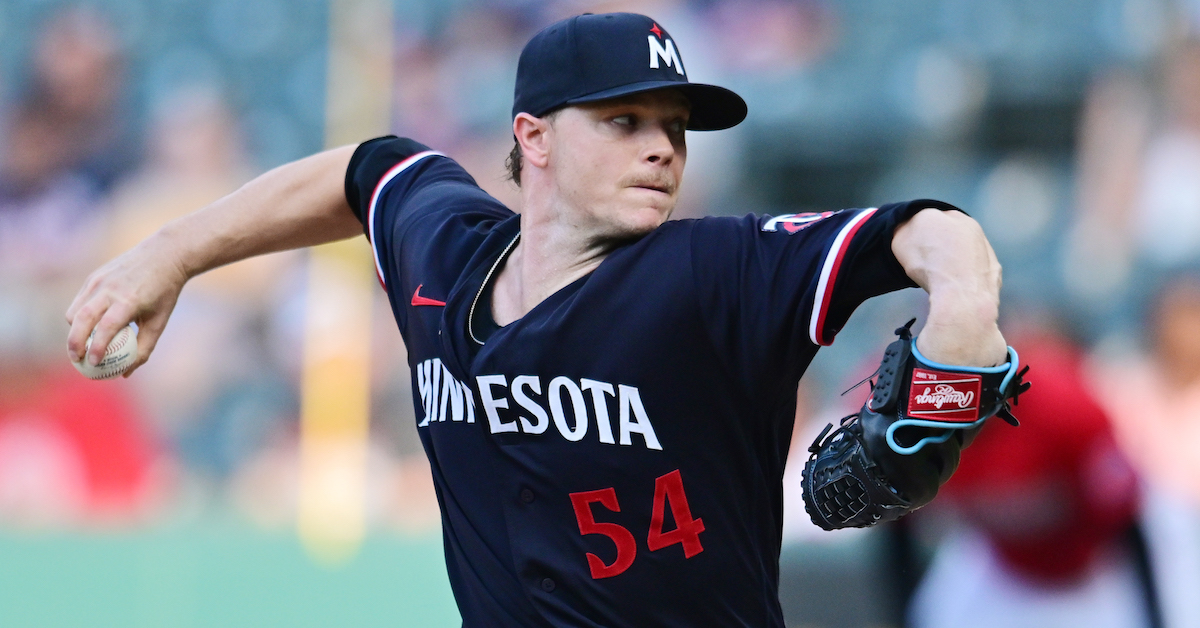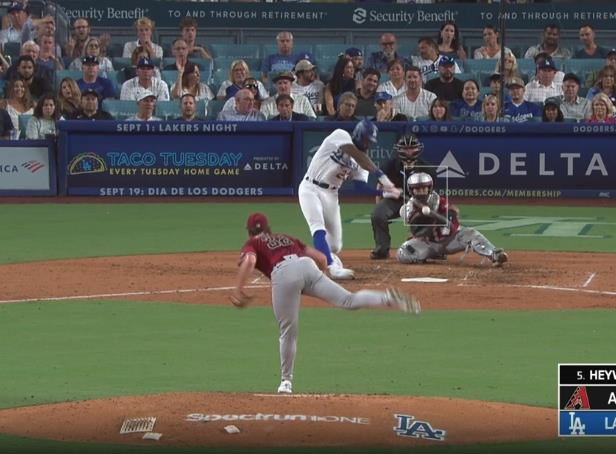
Ken Blaze-USA TODAY Sports
Pitchers mostly don’t throw sweepers to opposite-handed batters. Starters especially don’t throw sweepers to opposite-handed batters. To put a number on it, 227 starters threw 250 or more pitches to opposite-handed hitters in 2023. Only 18 of that group chose sweepers even 10% of the time. Everyone knows the math: It’s the kind of pitch that simply doesn’t work when opponents get a clean look at it.
Want further proof? When pitchers have deigned to throw this suboptimal pitch, they’ve gotten punished for it. Per Baseball Savant, starters threw 4,734 oppo sweepers and accumulated 43.6 runs of negative value relative to average for their troubles. In other words, it’s generally a poor option. It’s not quite “break glass in case of emergency,” but it’s not far off. Starters rely on changeups, splitters, vertical breaking balls, or cutters to get by; anything to avoid throwing sweepers.
Okay, now that I gave you that setup, here’s the deal: It’s not universally true. Two Cy Young contenders and a top prospect have bucked the trend, throwing sweepers with relative abandon and getting away with it. What gives? Let’s look at each in turn.
First up, we have Sonny Gray, whose ability to manipulate breaking balls has always been spectacular. He throws a curveball and a cutter in addition to his sweeping slider, which gives hitters more looks to worry about. With opponents off balance, he actually attacks the zone more frequently with his sweeper when he’s facing lefties. He throws it in the strike zone about 40% of the time, even with two strikes; compare that to roughly 26% of the time when he gets to two strikes against righties.
That seems counterintuitive, but I think it makes a lot of sense. The scouting report against Gray is straightforward: try to hit a fastball early, and if you fall behind, try as hard as possible not to chase. He doesn’t strike all that many batters out, but it’s not because he doesn’t have the requisite swing-and-miss chops; it’s because he attacks the zone with fastballs early. Despite a middling strikeout rate overall, he’s in the top quarter of pitchers when it comes to converting two-strike counts into Ks.
So Gray flips the script. He uses his sweeper in two different ways, both of which are effective. First, there’s the standard plan, a sharp, vanishing breaker that no one is putting into play:
That pitch is so obscene that I’m surprised network censors allow us to watch it. But that’s just a standard back-foot slider, and the truth is that Gray gets chases at an average rate despite that phenomenal movement. It’s nice, no doubt, but what really sets him apart, sweeper-wise, is that he can dot the outside corner, too. Here’s José Ramírez later in the same game:
Oh my. That hardly seems fair. Gray got nine of those looking strikeouts on his sweeper last year, the most in baseball for a righty against lefty hitters. He recorded 42 sweeper strikeouts against lefties overall, a number that easily lapped the field; Shohei Ohtani finished second with 27 – shout out to Ken Waldichuk, who racked up 37 as a lefty starter, though he needed 150 more sweepers than Gray to hit that number. Gray threw a ton of sweepers that opponents didn’t swing at, but he mixed things up enough that he drew a fair share of swings on pitches outside the zone anyway, and also stole some strikeouts when hitters were trying to lay off.
In other words, Gray’s sweeper works against lefties because he uses it as an out pitch. He threw 198 sweepers to lefties in 2023, and 149 of them came with two strikes. Per Savant’s run values, his sweeper racked up 8.6 runs above average in two-strike counts. The next-best starter checked in at 1.3 runs. That’s some kind of gap.
But don’t try this plan if you have only a middling pitch. Gray’s sweeper might be the best in baseball. Our Stuff models do the computer equivalent of drooling when they consider the pitch: It gets a 65 PitchingBot grade (out of 80, tied for third in baseball) and a 122 Stuff+ mark (ninth). Want to beat lefties with your righty sweeper? Just have it be the nastiest pitch imaginable. As a side note, Gray’s anti-slider rant is a lot funnier now that he’s doing just what he said he couldn’t and prospering.
That brings us to Pablo López, Gray’s 2023 teammate and the pitcher who racked up the second-most value by throwing sweepers to opposite-handed batters. López can’t match Gray’s absolutely ludicrous movement. They both threw their sweeping sliders with similar velocity (84.4 mph for López, 84.3 mph for Gray), but Gray’s version of the pitch drops 6.1 more inches and runs 2.4 more inches gloveside. But López’s pitch still grades out really well; in fact, PitchingBot thinks it’s ever so slightly better than Gray’s (Stuff+ says it’s the 17th-best slider in baseball, hardly a bad mark).
Without that otherworldly movement profile, López can’t use his pitch to rack up outs in the same way that Gray does. In fact, he throws it less than half as frequently as Gray with two strikes. His changeup and curveball both function as out pitches against lefties, so the sweeper is more of a change of pace than anything else. Instead, he distributes his sweeper usage throughout the count roughly evenly, part of a five-pitch mix that keeps hitters off balance.
The secret of López’s success isn’t that he never lets opposing batters hit the pitch; it’s that he doesn’t surrender much damage when they do put it in play. When lefties made contact with a López sweeper, they either hit it on the ground or popped it up 55% of the time. We’re dealing in a small sample size here, though; only 31 batted balls in 2023, hardly enough for a conclusive reading.
Is it possible that López has cracked the code of throwing sweepers with a platoon disadvantage? Maybe, but unlike Gray, I think it’s more likely that he’s just the beneficiary of a small sample. He’s undoubtedly good with the pitch, both in terms of its raw quality and the way he uses it. But the truth is, it’s just another option for him against lefties. Sure, he threw the third-most sweepers to lefties among all righty starters last year, but it was all over the count, rather than with a clear plan of attack like Gray. And as befits a Ben Clemens article, here’s a GIF of that lovely sweeper before we move on:
That brings us to our last high-usage, high-effectiveness righty. Brandon Pfaadt didn’t have a banner year in 2023, but he improved as the season wore on, and his best pitch is definitely his sweeper. It’s an entirely different sort of pitch than Gray’s. For instance, it’s slower, yet drops 10 inches less on its path home. Pfaadt relies on horizontal movement and release point to create an unconventional look. (Alex Chamberlain featured Pfaadt in his primer on horizontal approach angle.)
If you’re looking for what this means in a few words, here’s my best shot at synthesizing it. Pfaadt releases the ball from a low arm slot, so it’s already naturally headed right to left (from his vantage point) as it heads home. By emphasizing the horizontal movement of the pitch, he gives hitters something strange and uncomfortable to look at. Here’s a home plate view of Pfaadt’s sweeper:
That’s just uncomfortable for LaMonte Wade Jr. — it was more or less right down the middle, and Wade was likely taking all the way on 2-0, but that kind of angle and movement are hard to track. Per Alex’s research, pitches with outlier horizontal approach angles perform at their best when they’re located either on the inside or outside corner and break sharply towards the hitter. That’s exactly what Pfaadt’s sweeper does.
This effect works two ways. On the outside edge, it leads to more called strikes. Think Gray’s mastery of that outside edge; with a huge approach angle, hitters are apt to give up on the pitch because they don’t expect it to have enough horizontal movement to clip the corner. On the inside corner, it works a little differently; extreme approach angles lead to weaker contact as batters get sawed off. And that’s why Pfaadt fits into this group: he survives despite not missing many bats because he’s escaping with minimal damage on balls in play.
I have a hard time convincing myself of why Pfaadt can keep getting away with this, but I also believe Alex’s research. It helps explain why a pitch without an extreme movement profile has been so effective; it’s a perfect pairing of movement and arm slot that combine to make for an uncomfortable at-bat. And as Alex pointed out, shifting from the third-base side of the rubber to the first-base side took Pfaadt’s sweeper even farther from the ordinary. Hitters are good at pattern recognition. Throwing something way different than the norm is a good way to put them on the back foot, and Pfaadt’s slider does just that. It doesn’t fall as much as you’d think, and it gets in on a lefty’s bat more than they’d think; that’s how Jason Heyward ended up popping out here instead of smashing a line drive:
Here’s a screenshot that will hopefully explain what happened:

Heyward’s bat path, just before contact, would be perfectly placed to smash a pitch on the low outside corner. That’s where he got the head of the bat. But Pfaadt’s sweeper didn’t fall as much as Heyward expected, and it also ended up farther inside. That same pitch, thrown from a higher release point, would have been tattooed. Most righties can’t throw it, but it works really well from Pfaadt’s combination of mound position and arm slot.
So there you have it. Most righties can’t get away with throwing sweepers to lefties, but that doesn’t mean that none of them can. All you have to do is throw maybe the best sweeper on the planet, like Gray. Or feature your sweeper as part of a mix of five above-average offerings, like López. Or attack from a wild angle, like Pfaadt. In other words, just like the rest of pitching, the surest way to succeed at this particular skill is by being very good overall. Baseball sure seems easy when you put it like that.
Source
https://blogs.fangraphs.com/have-sonny-gray-pablo-lopez-and-brandon-pfaadt-cracked-the-sweeper-code/
 Backyard GrillingWeekend WarriorsAdvice from DadBeard GroomingTV Shows for Guys4x4 Off-Road CarsMens FashionSports NewsAncient Archeology World NewsPrivacy PolicyTerms And Conditions
Backyard GrillingWeekend WarriorsAdvice from DadBeard GroomingTV Shows for Guys4x4 Off-Road CarsMens FashionSports NewsAncient Archeology World NewsPrivacy PolicyTerms And Conditions
